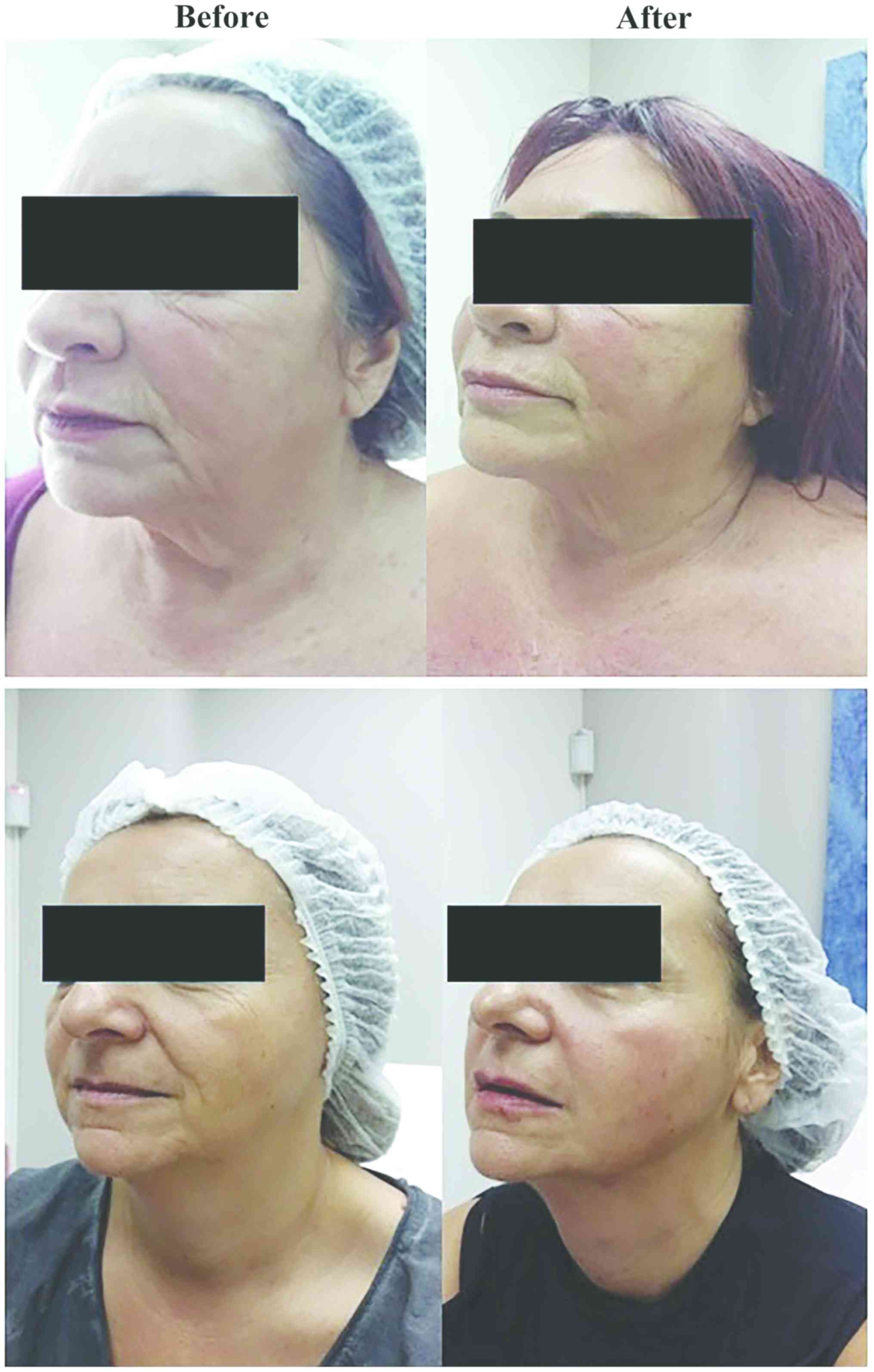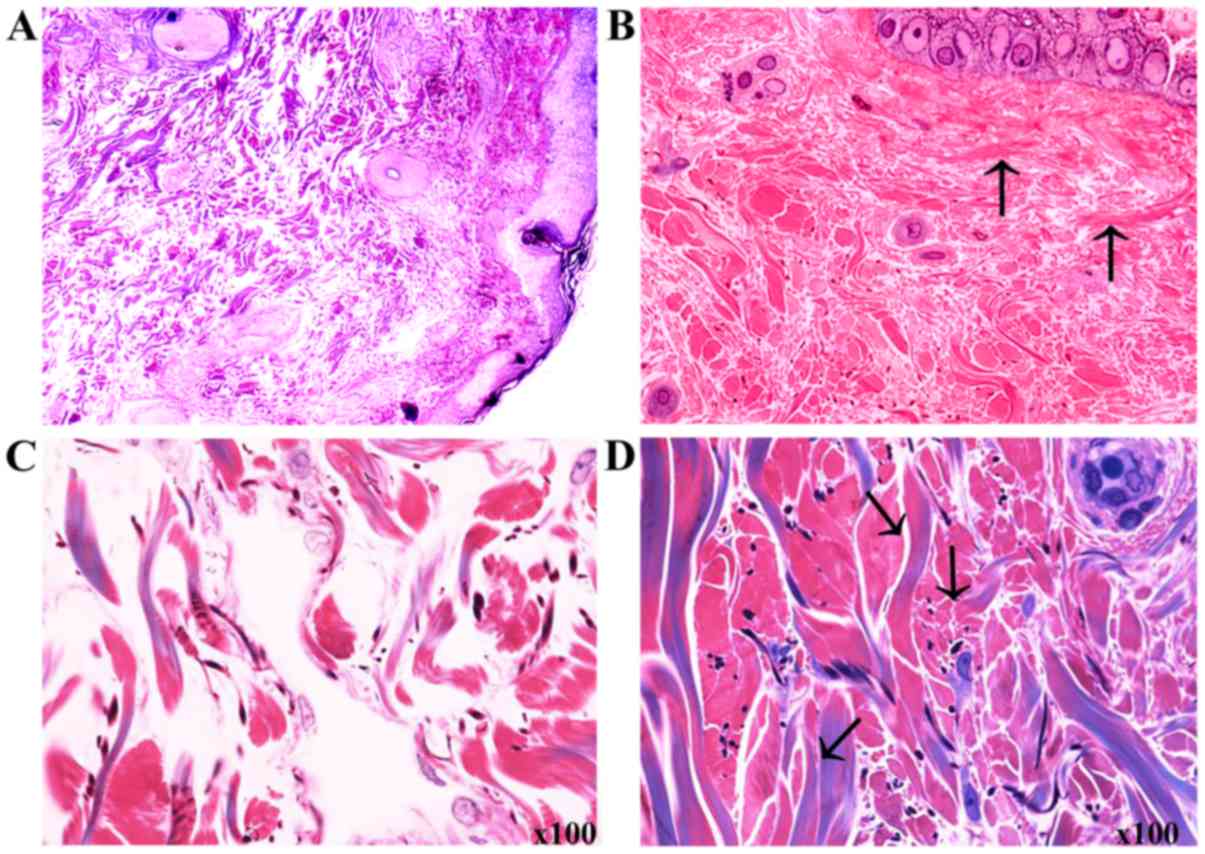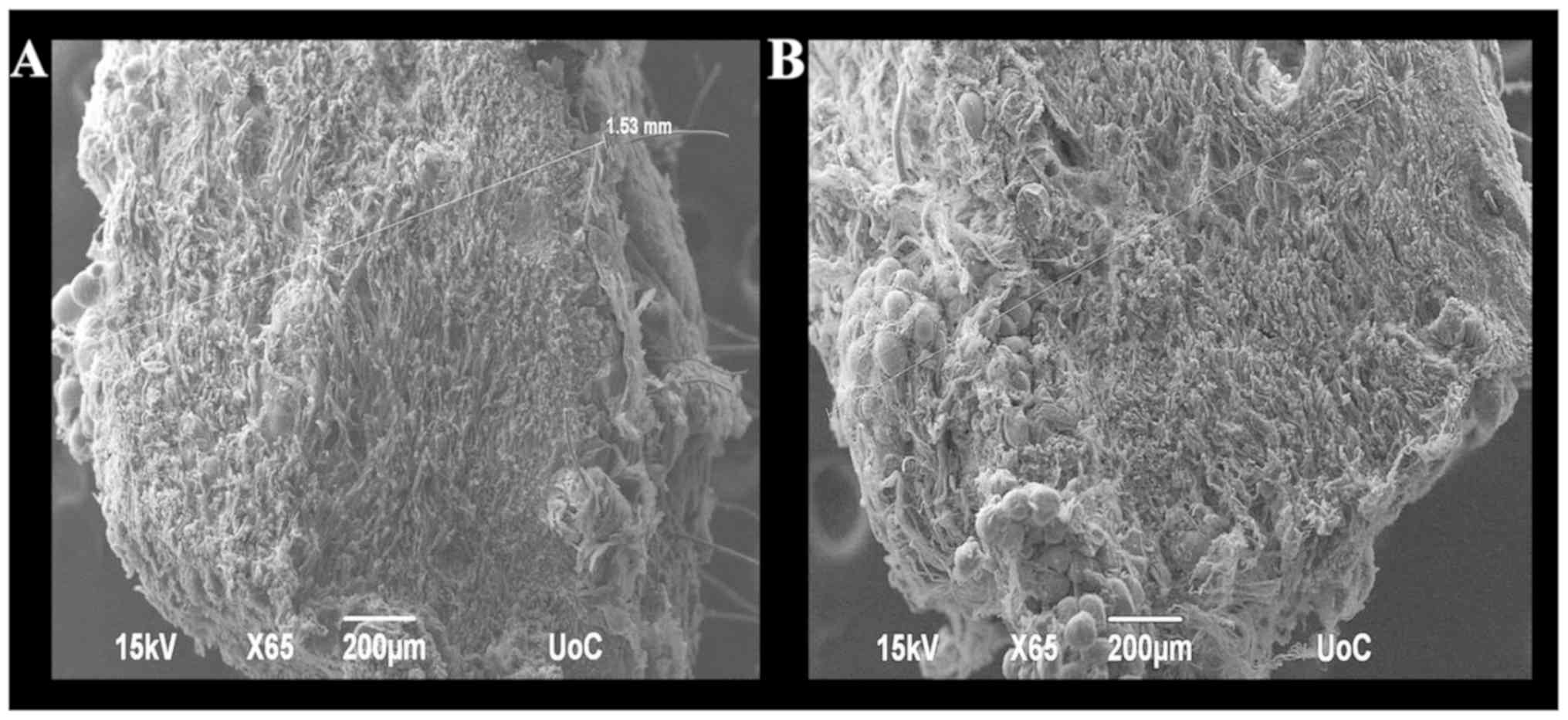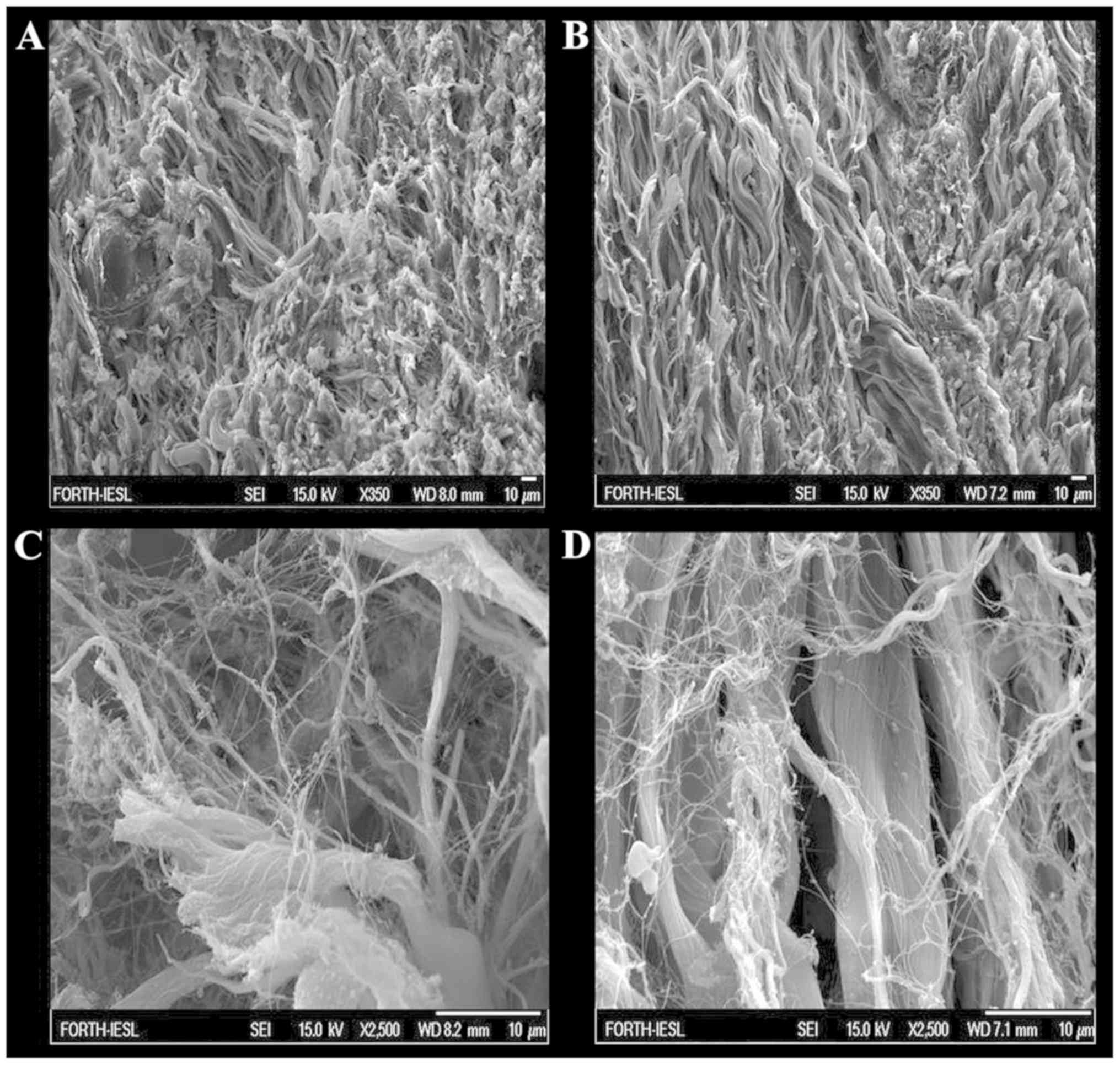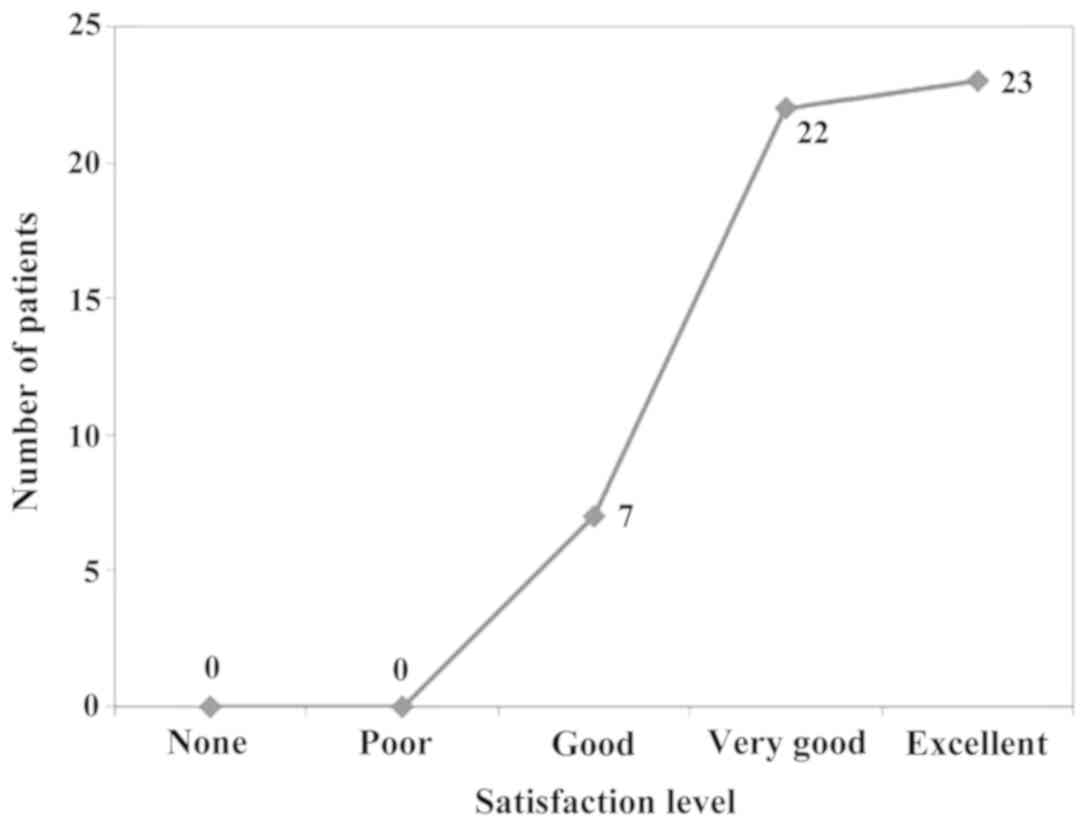Introduction
Skin is the largest body organ composed of the
epidermis, dermis and hypodermis layer. Skin is heterogeneous,
anisotropic and a non-linear viscoelastic material (1). Thus, the skin exhibits both viscous and
elastic characteristics when undergoing deformation (2). The viscoelastic properties of the skin
predominantly originate from its dermis compartment that is
composed mostly of extracellular matrix sparsely populated by
fibroblasts. Supporting cells in skin structures depends on a
variety of factors, such as hyaluronan (HA), an unsulfated
glycosaminoglycan that is an important component of the
extracellular matrix network (3,4) The
dermis extracellular matrix consists mainly of collagen fibers
(type I and type III), elastin and proteoglycans (1).
The mechanical properties of the skin largely depend
on the nature and organization of dermal collagen and the elastic
fibers network. Indeed, the collagens are responsible for the
mechanical strength of the skin, whereas the elastic fibers bestow
elasticity to the skin (5). The
mechanical properties of the collagen matrix depend on the fine
characteristics of the respective collagen types and their
self-assembly as regards fiber length, fiber volume fraction and
collagen molecular stretching, as well as the tilt angle of
collagens determining its orientation (5). The diameters of papillary collagen
fibers are in the range of 0.3 to 3 µm (6), whereas those of reticular collagen are
in the range of 10–50 µm (7).
Importantly, the mechanical properties of the skin alter with
aging, crucially contributing to the appearance of wrinkles and
sagging skin. These changes are closely associated with the
collagen matrix, as collagen fibers change with age, becoming
denser and begin to ‘unravel’ (8).
There are several methods derived from classical
acupuncture that are intended for the treatment of various skin or
musculoskeletal conditions. The embedding method uses threads in
subcutaneous tissue or muscles at specific points in order to treat
musculoskeletal pain (9). Another
variant uses micro-needles to create microwounds that stimulate
fibroblast proliferation and dermal neovascularization, which is
applied in the treatment of facial wrinkles (10). Needle-shaping uses very fine needles
through which high tension and limited galvanic current are
applied. This microsurgical technique, invented by Fippi in 2012
(11), has been established to be
safe and able to physically reshape different body parts. Vibrance,
the only medical device on the market able to perform needle
shaping, has been found to improve the collagen matrix organization
of aged skin. Specifically, the Vibrance machine uses 3 mixed
currents which act synergistically, and thus result in a slight
dehydration of the dermal elastic and collagen fibers, which in
continuation, hook onto the needle and principally bind to each
other. The respective currents are finely modulated at such an
intensity so as to not be perceived by the patient, with the
possible exception of particularly sensitive regions. To the best
of our knowledge, no study to date has examined the effects of
needle shaping on skin morphology and collagen structure. Thus,
this was the aim of the present study.
Patients and methods
Patients
The group of patients recruited in this study
consisted of 54 females in the age range (40–65 years) with varying
extents of skin laxity. The study, including patient material, was
performed in accordance with the Declaration of Helsinki (1964) in
its latest amendment. Patient survey and clinical procedures were
performed in accordance with the ethical approval 17/12.12.2016
provided by SkinClinic, Heraklion, Greece. All patients signed
statements of informed consent for participating in the study.
Procedures
The patients underwent the needle shaping procedure
in the period from January, 2017 up to January, 2018. Acupuncture
needles sized 0.18×40 and 0.20×60 (a LKB 2088 Ultrotome V) were
used for the application of the needle shaping technique. The
Vibrance machine uses 3 mixed currents imperceptible to patients.
The electrical currents are programmable with basic parameters and
their effect is enhanced by their synergic action. Four sessions of
4 treatments lasting 30 min were performed at day 0, 15, 30 and day
45. During the treatment, the women did not take hydrolyzed
collagen orally and the skin care was basic, with moisturizing
creams, and they did not receive creams or booster serum.
Macroscopic analysis and scoring
The macroscopic results of the procedure were
evaluated by an independent dermatologist. Particularly, all
patients were evaluated prior to the first session of treatment and
15 days after the final one (day 60). In addition, patients were
asked to assess the outcome of the procedure in terms of personal
satisfaction, by using the visual analog scale (VAS) at the same
time. The assessment of satisfaction in this study was performed
using the VAS score (12). A VAS for
satisfaction is a horizontal line of 100 mm in length. At the
beginning and at the end, there are 2 descriptors representing
extremes of satisfaction (no satisfaction and extreme
satisfaction). Patients rated their satisfaction by making a
vertical mark on the 100-mm line. The measurement in mm was
converted to the same number of points ranging from 0 to 100
points. The exact question was ‘Are you satisfied with your
procedure?’ A standard explanation of how to complete the VAS form
was mentioned beneath the VAS horizontal line. Satisfaction on VAS
was categorized as poor (range, 0–25), good (range, 26–50), very
good (range, 50–75) and excellent (range, 76–100).
Histological analysis
A histological evaluation was performed on 5 female
patients. Initially, a skin biopsy was obtained surgically from the
skin behind the left ear (untreated area). At 15 days after the
final session (day 60), a biopsy was taken in the treated skin area
behind the right ear and examined by optical (pathologist) and
scanning electron microscopy (SEM). For light microscopy (LM),
small tissue blocks were fixed, both in 2% glutaraldehyde
(Germiphene) and 2% paraformaldehyde (Germiphene) in 0.1M
cacodylate buffer, pH 7.4 (Karnovsky's fixative, Electronic
Microscopy Sciences), stained with 2% osmium tetroxide at room
temperature for 2 h (Electronic Microscopy Sciences), dehydrated in
a graded series of ethanol (Germiphene) and embedded in epoxy resin
(Electronic Microscopy Sciences). Sections were cut on a LKB 2088
Ultrotome V microtome at a thickness of 1 µm, transferred to a
water droplet on a gelatin-coated slide, and placed on a slide
warmer plate at 50°C. After drying, the sections were stained with
a trichrome stain (Electronic Microscopy Sciences) according to a
staining protocol for collagen fibres and viewed using a Nikon E800
light microscope. The samples were evaluated by a qualified
pathologist who was unaware as to the identity of the samples.
For SEM, the Karnovsky-fixed tissue blocks were
post-fixed with cacodylate buffered 2% osmium tetroxide (pH 7.4),
for 2 h, dehydrated in a graded series of ethanol, and dried using
the critical point drying method with a BAL-TEC, CPD-O30 critical
point dryer. The specimens were coated with gold, and viewed using
a scanning electron microscope (JEOL JSM 7000F; JEOL Ltd.).
Results
Patient data
Data from 52 patients were available for analysis,
since 2 patients missed follow-up. The results of this study
demonstrated good to excellent construct validity. None of the
patients had adverse effects with the minor exception of short-term
redness and mild ecchymosis. Indeed, there was no downtime or
side-effects associated with this treatment apart from some redness
that lasted for half an hour. Ecchymosis in some cases may have
lasted for a few days.
Clinical assessment
Assessment by an independent dermatologist confirmed
that skin laxity and tone had markedly improved in all patients
resulting in a younger, fresher, healthier and brighter appearance
of the patients' skin. Moreover, a reduction of wrinkles and fine
lines was observed, as well as an increase in skin collagen and
elasticity, with the skin looking more plumed and naturally
‘lifted’ without the aid of foreign substances that can sometimes
alter facial features. As regards both criteria, in all cases, a
significant improvement of skin tone was evident (Fig. 1).
Laboratory assessment
Moreover, in the case where a biopsy pre- and
post-treatment was obtained, both the macroscopic, as well as
histological characteristics of the skin were found to be
significantly improved (Fig. 2).
Trichrome staining demonstrated a more compact
dermis, with a healthy matrix network (Fig. 2B and D). Specifically, the collagen
fibers were larger and thicker with a more ordered alignment of
fibers of the treated skin as compared to the pre-treatment
condition (Fig. 2A and C).
This finding was also confirmed by electron
microscopy. The examination of the treated dermis by SEM
demonstrated an increased dermis thickness (Fig. 3B) compared with the pre-treatment
condition (Fig. 3A).
The examination of the dermis specimens by SEM at a
higher resolution demonstrated that collagen the fibers before
treatment were disorganized and of poorer quality (Fig. 4A and C). The needle shaping treatment
enhanced collagen production, resulting in the formation of better
organized, good quality fibers of a more ordered alignment
(Fig. 4B and D).
Patient satisfaction
A total of 52 patients were available from the
follow-up. The results demonstrated good to excellent construct
validity. The results were as follows: Poor, 0 cases; good, 7
cases; (13.46%); very good, 22 cases (42.30%); and excellent, 23
cases (44.23%) (Fig. 5).
Discussion
Rejuvenating the skin by stimulating the body's own
regeneration mechanisms without surgery has an increasing
popularity. Skin needling techniques are used in dermatology for
various diseases: Post acne scars, particularly in severe forms
resistant to conventional classical treatment (13,14),
re-pigmentation of hypopigmentation scars after burns, melasma,
non-acne scars such us atrophic scars following varicella infection
or to combat aging skin.
The results of this study demonstrated a good
anti-aging effect and are comparable in efficacy with those of
another study (15) that have used
different micro-needling techniques. The results were analyzed 15
days after the end of the final session. The mode of action of
needle shaping follows the mechanism of wound healing. The collagen
production begins to recreate after the first 7 days of skin injury
(15).
Fractional radiofrequency micro-needling has been
used for skin rejuvenation in a group of 15 women. These were
treated on one side of the face with monotherapy and in the control
lateral part was added in addition stem cell conditioned medium.
Fine wrinkles were reduced and the overall appearance was improved
on the side where stem cells were added. From a histological point
of view, an increased production of neo-collagen, similar to our
study was observed with minimal side-effects: Mild erythema and
procedural pain (16).
An ideal treatment for stimulating the production of
collagen and elastin in the dermis is percutaneous collagen
induction therapy. It uses a dermaroller, a cylindrical device
fitted with needles, which is rolled back and forth and produces
thousands of stings in the papillary dermis (17). Histological examinations demonstrated
a considerable increase in collagen and elastin deposition, the
epidermis has shown a thickening of the spinosum layer. However,
the method involves more bleeding, is painful and requires local
anesthesia (17).
Further studies are required in the future to
confirm the current findings. These techniques may open new
non-surgical horizons in aesthetic medicine, anti-wrinkle
treatments and anti-aging treatments with improvements in skin
quality.
The assessment of satisfaction is difficult as it is
a multifaceted expression of affective, cognitive, physical,
sensory, behavioral, social, cultural and subjective feelings. One
of the potential methods of measuring satisfaction is by using the
well-known VAS. The VAS satisfaction is a simple and valid
instrument for the quantification of the satisfaction of the
patient following aesthetic procedures; however, it cannot be used
as the only outcome measurement. The VAS satisfaction is a useful
addition to subjective and objective outcome measurement in
documenting the results of the needle shaping.
In this study, all enrolled patients reported full
satisfaction with the results. In general, the improvement of the
treated skin area was dependent on the initial skin laxity and the
requirements of the patient for perfect results.
However, satisfaction was not used only to measure
the amount of improvement over time, but also to benefit from
having knowledge of the patient's opinion regarding the clinical
results. For this reason, we wished to have a more detailed
documentation as to the following issues: How effective the
treatment was and consequently how much the dermis area becomes
affected after the needle shaping treatment has been performed.
In conclusion, needle shaping can be characterized
as an auto-transplantation of tissue produced by our own body
mimicking threads. Natural results are obtained and importantly,
the patient physiognomy is not altered. Macroscopically, the
results are visible from the very first treatment. The
dermatological evaluation determined that skin laxity and tone had
been improved, resulting in younger, fresher appearance of the
facial skin. According to the findings of this study, the needle
shaping technique has been proven to be effective and safe,
followed only by very mild complications. The skin becomes,
brighter, tighter of a visibly younger appearance, while
microscopic examination revealed a denser dermis populated with
larger, thicker and more correctly organized collagen fibers.
Needle shaping is indicated as an innovative aesthetic strategy for
improving skin tone and volume with zero side-effects.
Acknowledgements
Not applicable.
Funding
No funding was received.
Availability of data and materials
All data generated or analyzed during this study are
included in this published article or are available from the
corresponding author on reasonable request.
Authors' contributions
All the authors (MS, DC, AOD, ST, MSK, SP, PF, DEB,
KK, JT and DAS) contributed equally to the conception and design of
the study. MS, DC and DEB, KK contributed to sample collection. ST,
SP, PF, JT and DAS worked and interpreted the histological
evaluation and scanning electron microscopy. MA, DC, AOD and MSK
drafted and wrote the manuscript. MA, DC, AOD, MK, DEB, KK and DAS
provided advice on the experimental design, interpreted the results
and critically revised the manuscript. All authors have read and
approved the final version of the manuscript.
Ethics approval and consent to
participate
Patient survey and clinical procedures were
performed in accordance with the ethical approval 17/12.12.2016
provided by SkinClinic, Heraklion, Greece. All patients signed
statements of informed consent for participating in the study.
Patient consent for publication
All patients agreed for their data to be
published.
Competing interests
DAS is the Editor-in-Chief for the journal, but had
no personal involvement in the reviewing process, or any influence
in terms of adjudicating on the final decision, for this article.
The other authors declare that they have no competing
interests.
References
|
1
|
Ross MH, Kaye GI and Pawlina W: Connective
Tissue in Histology: A text and Atlas. Lippincott Williams &
Wilkins; Pensylvania, PA: 2003
|
|
2
|
Silver FH, Freeman JW and DeVore D:
Viscoelastic properties of human skin and processed dermis. Skin
Res Technol. 7:18–23. 2001. View Article : Google Scholar : PubMed/NCBI
|
|
3
|
Kavasi RM, Berdiaki A, Spyridaki I, et al:
HA metabolism in skin homeostasis and inflammatory disease. Food
Chem Toxicol. 101:128–138. 2017. View Article : Google Scholar : PubMed/NCBI
|
|
4
|
Nikitovic D, Berdiaki A, Galbiati V,
Kavasi RM, Papale A, Tsatsakis A, Tzanakakis GN and Corsini E:
Hyaluronan regulates chemical allergen-induced IL-18 production in
human keratinocytes. Toxicol Lett. 232:89–97. 2015. View Article : Google Scholar : PubMed/NCBI
|
|
5
|
Agache PG, Monneur C, Leveque JL and De
Rigal J: Mechanical properties and Young's modulus of human skin in
vivo. Arch Dermatol Res. 269:221–232. 1980. View Article : Google Scholar : PubMed/NCBI
|
|
6
|
Brown RA, Shuttleworth CA and Weiss JB:
Three new alpha-chains of collagen from a non-basement membrane
source. Biochem Biophys Res Commun. 80:866–872. 1978. View Article : Google Scholar : PubMed/NCBI
|
|
7
|
Smith LT and Holbrook KA: Development of
dermal connective tissue in human embryonic and fetal skin. Scan
Electron Microsc (Pt 4). 1745–1751. 1982.
|
|
8
|
Lavker RM, Zheng PS and Dong G: Aged skin:
A study by light, transmission electron, and scanning electron
microscopy. J Invest Dermatol. 88 (Suppl 3):44s–51s. 1987.
View Article : Google Scholar : PubMed/NCBI
|
|
9
|
Yun Y and Choi I: Effect of thread
embedding acupuncture for facial wrinkles and laxity: A single-arm,
prospective, open-label study. Integr Med Res. 6:418–426. 2017.
View Article : Google Scholar : PubMed/NCBI
|
|
10
|
Cho JH, Lee HJ, Chung KJ, Park BC, Chang
MS and Park SK: Effects of Jae-Seng Acupuncture Treatment on the
Improvement of Nasolabial Folds and Eye Wrinkles. Evid Based
Complement Alternat Med. 2015:2739092015. View Article : Google Scholar : PubMed/NCBI
|
|
11
|
Fippi G: Elettrochirurgia a flusso di
elettroni convogliati. Trattato di medicina estetica. Massirone A:
1. 1st. Piccin-Nuova Libraria; Padova: 2010, pp. 1238–1249
|
|
12
|
McCormack HM, Horne DJ and Sheather S:
Clinical applications of visual analogue scales: A critical review.
Psychol Med. 18:1007–1019. 1988. View Article : Google Scholar : PubMed/NCBI
|
|
13
|
Ianoşi S, Ianoşi G, Neagoe D, Ionescu O,
Zlatian O, Docea AO, Badiu C, Sifaki M, Tsoukalas D, Tsatsakis AM,
et al: Age-dependent endocrine disorders involved in the
pathogenesis of refractory acne in women. Mol Med Rep.
14:5501–5506. 2016. View Article : Google Scholar : PubMed/NCBI
|
|
14
|
Ianosi S, Neagoe D, Branisteanu DE,
Popescu M, Calina D, Zlatian O, Docea AO, Marinas MC, Iordache AM,
Mitruț P, et al: Comparative efficacy of oral contraceptive versus
local treatment versus intense pulsed light combined with vacuum in
endocrine acne in women. J Biol Regul Homeost Agents. 32:711–718.
2018.PubMed/NCBI
|
|
15
|
Tsioumas S, Vlachodimitropoulos D and
Goutas N: Clinical And Histological Presentation After Plexr
Application, Needle Shaping (Vibrance) and O.F.F. Pinnacle Med Med
Sci. 2:522–530. 2015.
|
|
16
|
Seo KY, Kim DH, Lee SE, Yoon MS and Lee
HJ: Skin rejuvenation by microneedle fractional radiofrequency and
a human stem cell conditioned medium in Asian skin: a randomized
controlled investigator blinded split-face study. J Cosmet Laser
Ther. 15:25–33. 2013. View Article : Google Scholar : PubMed/NCBI
|
|
17
|
Aust MC, Knobloch K, Reimers K, et al:
Percutaneous collagen induction therapy: an alternative treatment
for burn scars. Burns. 36:836–843. 2010. View Article : Google Scholar : PubMed/NCBI
|















